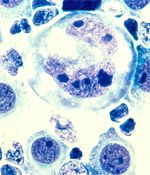Investigational Smac Mimetic TL32711 Targets Key Lymphoma Mechanism
A combination of TL32711, an investigational second mitochondrial-derived activator of caspases (Smac), and tumor necrosis factor-related apoptosis inducing ligand at low concentrations produced marked apoptosis in germinal center lines, with minimal to no effect for each agent alone.
CHICAGO-A combination of TL32711, an investigational second mitochondrial-derived activator of caspases (Smac), and tumor necrosis factor-related apoptosis inducing ligand (TRAIL) at low concentrations produced marked apoptosis in germinal center (GC) lines, with minimal to no effect for each agent alone. In the combination-treated GC types, caspases -3, -8, and -9 were significantly induced, confirming activation of both pathways, according to researchers at Fox Chase Cancer Center in Philadelphia (2012 AACR abstract 3857).

Human lymphoma tumor cells in the pleural fluid stained with a Defquick stain and magnified to 400x. Included are 2 variations. Source: Dr. Lance Liotta Laboratory.
“It’s an exciting time to be involved in lymphoma treatment and research,” said lead investigator Mitchell Smith, MD, PhD, director of lymphoma service at Fox Chase, adding that researchers are now a step closer to developing the first treatment to target a key pathway in lymphoma. “There’s a new understanding of the disease and the new drugs to treat it. I am optimistic that over the next couple of years treatments will continue to get even better and less toxic.”
Smac is the endogenous cellular antagonist of proteins that inhibit apoptosis (IAPs). Smac binds to and inhibits the activity of IAPs by inducing their degradation and eliminating their inhibitory effect on caspases and apoptosis. Smac mimetics such as TL32711 are a new class of small-molecule drugs designed to mimic the action of Smac. “TL32711 is like a double-negative,” said Dr. Smith. “It inhibits the inhibitor, and therefore makes cells more sensitive to dying.”
TL32711 is currently being investigated in phase II single-agent and combination clinical studies in solid tumors and in a phase I/II clinical study in acute myeloid leukemia. It is being developed by TetraLogic Pharmaceuticals under the name birinapant.
“We investigated the proapoptotic effects of TL32711, alone and in combination with TRAIL to activate the extrinsic pathway, in a panel of B-cell lymphoma cell lines representing GC/follicular versus activated B-cell (ABC) histologies,” Dr. Smith explained. “TL32711 had little effect as a single agent on any of these B-cell lymphoma cell lines at ≤ 100 nM, though apoptosis was induced at 10-20 µM in GC types. TRAIL alone (10-25 ng/ml) induced apoptosis in the three GC lines, but had little effect on the two ABC lines. These data suggest that clinical trials of TL32711 may focus on follicular and GC lymphoma in combination with TRAIL or TRAIL agonists.”
“This is a very interesting study,” commented Leonidas C. Platanias, MD, PhD, deputy director, Robert H. Lurie Comprehensive Cancer Center, and professor of oncology and professor of medicine, Northwestern University Medical School, Chicago. “The approach was innovative and the results of this work may have important clinical-translational implications in the future. The synergistic effects seen were potent and following up on this finding and further exploring the effects of combinations of TL32711 with TRAIL agonists or TRAIL in future research work is warranted.”